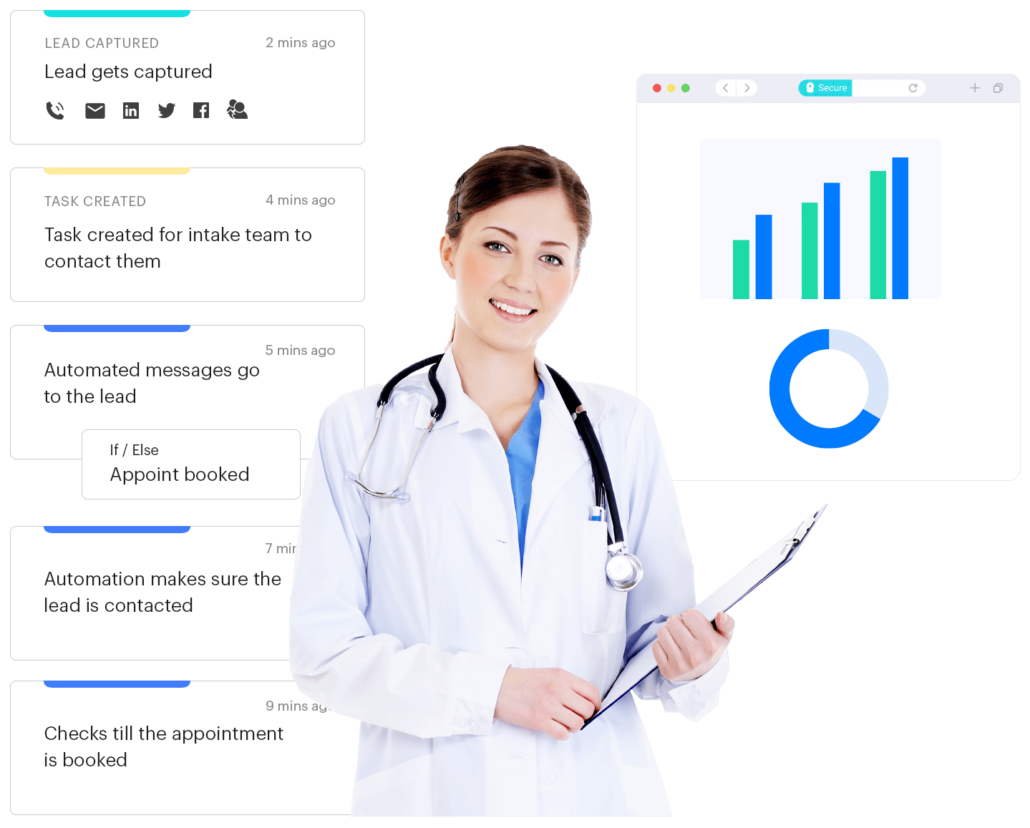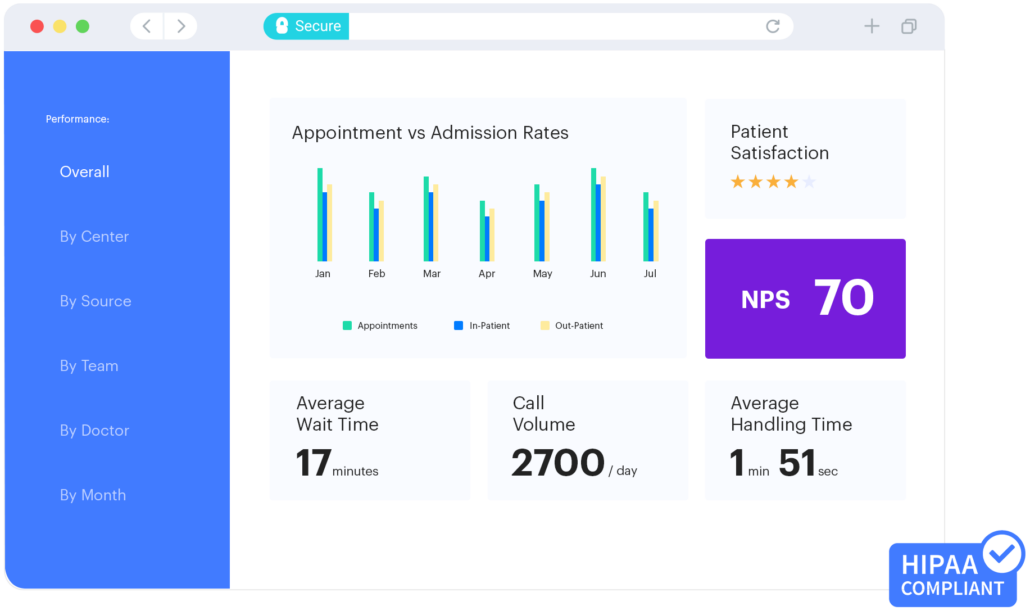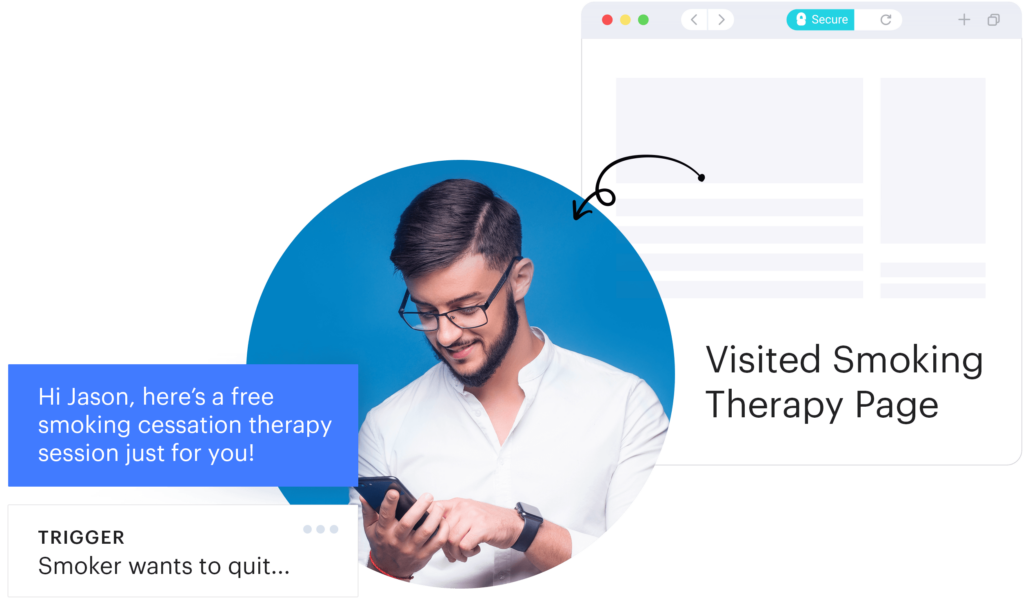What’s the first thing that comes to mind when you provide care for a patient?
Doctors agree that giving immediate and effective treatment is the #1 priority. Even better, if it is something you can prevent and treat in its early stages.
But carrying out these processes manually is exhausting. Especially when you’re drowning in paperwork and reports.
Healthcare organizations are rapidly adopting technology to manage patient-related activities more effectively. A patient management software is one such tool that you need to improve your healthcare practice’s efficiency.
But before we get into the benefits or features, let’s first understand what patient management software is.
What is patient management software system?
A Patient Management Software or PMS is a tool to manage administrative tasks and store patient records. Patient management isn’t limited to scheduling an appointment, evaluation, treatment, and discharge. Healthcare professionals also need to build meaningful relationships with patients to facilitate care delivery and an excellent patient experience.
Essentially, patient management takes up a lot of time but a patient management system can automate the following functions to allow your doctors to spend more time with their patients instead:
- Appointment scheduling
- Faster patient admission using e-forms
- Recording interactions
- Managing referrals
- Payment processing
- Updates electronic healthcare records
Patient management software also allows you to enable patient portals for healthcare staff to access test results, prescriptions, medical history, and more.
These are just some of several features you can use with patient management software. But there are a lot of other challenges that healthcare workers face. Let’s look at how patient management software can solve them.
Challenges faced by healthcare professionals
Today, patients want advanced and efficient care at short wait times. At the same time, doctors and healthcare professionals want to concentrate on treatment rather than paperwork and reports.
Below are some of the most common challenges they face due to the lack of a PMS:
- Inconsistent appointments, inefficient processes, and high healthcare costs.
- Heaps of patient information that is manually recorded.
- Lack of reliable patient history records and gathering.
- Inability to share information across departments or locations.
- Changes in treatment are rarely communicated on time.
- Payment processes can be long-winding and involve different insurance companies.
- The patient experience worsens with long wait times and inefficient care.
This is just the tip of the iceberg when it comes to healthcare. In the meantime, patients have higher expectations of doctors and the healthcare sector.
Your prospective patients consult Google before they choose a provider. For instance, 94% of patients read online reviews when selecting a doctor or provider. Therefore, online presence has become necessary, but almost every provider has a website.
The only differentiator is patient satisfaction.
So, what can you do to meet these expectations?
Implement a Patient Management System!
Features of patient management software [and their benefits!]
As we have seen, administrative tasks take up a lot of time, which could otherwise be spent delivering better care to patients.
Hospitals and private practices aim at reducing operational costs to increase profitability. Let’s look at a few features of patient management software that make it a great aid in this pursuit..
1. Schedule appointments at ease
Appointment scheduling is an inescapable aspect of any in-person interaction. Recent research shows that:
- Around 48% of patients prefer to arrange appointments over the phone.
- In contrast, 43% prefer to book appointments online. And this number is increasing every year.
The above numbers confirm that online channels for communication are an essential part of your patient management system. Not implementing them can also result in decreased patient acquisition.
A patient management system can ensure that you effectively schedule any future appointments. It can track and record information from various sources. Thus, allowing you to follow up with patients and reduce no-shows. It makes it simple to book appointments for patients as well. Patients can check the doctor’s availability and book an appointment online.

Appointment automation immensely reduce wait times and evenly distribute leads among providers. It also manages patient-to-medical-staff communication to confirm diagnostic and treatment sessions.
Some patient management systems like Healthcare CRM integrate with EHR to access and update patient information. Others collect and process critical patient data for use in the billing software.
2. Record patient information and their medical history
Healthcare providers should be able to easily track, store, and access their patients’ medical records.
While both EHR and patient management system can store patient records, they serve different purposes. EHR systems are built to make heath records sharable and accessible across the healthcare ecosystem. Whereas a PMS tool ensures that you have access to all the patient interactions—even if they have consulted multiple departments.
With a PMS software and EHR, you easily get access to patient records, such as:
- Demographic information
- Vitals and personalized statistics like age and weight
- Medical history
- Drug and allergy information
- Vaccination status
- Laboratory test records and results
- Radiological pictures
- Payment details
Before selecting a patient information management system, figure out what you need. For instance, you should be able record, update, and archive critical patient data. It should take place within the system for access during future encounters.
3. Track all your patient interactions and touchpoints
The patient management system keeps track of and optimizes patient contact. It carries out such actions before they even enter the hospital. Electronic intake forms are typically generated by the patient check-in software module.
These forms are for them to fill out ahead of their visit. These processes speed up a patient’s first clinic or hospital appointment while simultaneously cutting down on time spent completing paperwork in person.
Patients will check-in online once they arrive, and the system logs their wait times. The patient’s wait time information provides metrics for performance evaluations.

Patient management software keeps track of:
- Exam room availability and the progress of each exam.
- Users can take notes immediately within the system
- Patient diagnosis and health concerns.
- Tracks the medical provider’s performance and care.
Patient engagement tools are another great asset to your PMS. Most engagement tools are features within the software.
Hospitals, medical offices, and other institutions need to meet healthcare consumer expectations. Most patients expect medical professionals to provide excellent personalized care. They want their providers to:
- Show compassion
- Acknowledge their needs
- Communicate quickly
- Provide easy access to relevant information.
Patient engagement tools make it easier to urge patients to take an active role in their care. It promotes the development of a collaborative patient-doctor connection. It eventually helps improve patient satisfaction and experience.
4. Medical transactions and billing software for seamless invoicing
Nobody likes to talk about money in healthcare, yet it’s an unavoidable part of the profession. Billing features in patient management systems help to relieve the strain of invoicing. Additionally, Research estimates the CAGR of medical billing software to grow at 5.1% from 2020 to 2027.
This feature in a PMS keeps track of all previous and existing payment details. Along with this, it records prescription details for patients and validates insurance eligibility when a patient checks in.
Patient management software automates the revenue cycle after contacts, prescriptions, procedures, or other services. This is to standardize every patient’s bill and revenue received. Some advanced systems even allow buying prescribed medicines from the network pharmaceuticals.
The software also sends out automated payment reminders when payments are due. In a nutshell, a patient management system:
- Keeps track of claim status
- Manages patient accounts
- Automates the billing process
- Sends payment reminders
- Allows online payment
Another benefit of the payments module of patient management system is it automates reminders through SMS, email, WhatsApp, etc. Thus, you won’t have to check accounts and remind patients to fulfil payments regularly.
5. Predictive reports and improved patient relationship management
Patient progress reports assist you in predicting what your patients might require. The predictions can be based on their:
- Actions and lifestyle
- Medical and genetic history
- Hereditary conditions and allergies
- Current health and existing illnesses

The PMS software helps predict future health concerns after analyzing such factors, boost patient retention rates, and enables patients to take efforts to avoid preventable diseases. Most doctors will agree that it’s far easier to overcome any illness when you curb it in its early stages.
Along with predictive reports, PMS helps you create meaningful doctor-patient relationships. Most patient management systems integrate with a CRM tool or are healthcare CRMs.
Patient relationship management is an essential aspect of hospital management. It helps you identify and close gaps in the treatment journey.
A PMS does this by providing speedy actionable insights about patient needs. For instance, imagine prospective patients leaving the health system following a consultation. This is a signal that you may need to reconsider your engagement plan.
Having access to these data will enable you to create well-informed engagement. This makes patients feel heard and involved, thereby enhancing your patient retention efforts. Patient management software raises the bar in terms of delivering care. It helps medical facilities of all sizes to:
- Provide personalized patient care with the help of analytics.
- Reduce patient wait times through the accurate distribution of patients to available providers.
- Schedule appointments based on availability and patient needs.
- Improve revenue cycles by digitizing billing processes and linking up with insurance providers.
By now, you must have realized the benefits a PMS can bring to your practice. Perhaps, the next question in your mind would be—which is the best patient management system?
Well, we’re here to answer that.
How to select the right patient management software for your practice?
With a plethora of options available in the market, how do you pick the software that aligns perfectly with your practice’s unique needs? Here are some essential factors to consider when choosing patient management software:
- Comprehensive Features: Evaluate the software’s features and ensure it encompasses all your required functionalities. From appointment scheduling and medical records management to billing and reporting capabilities, the software should provide a comprehensive solution that addresses your practice’s specific requirements.
- User-Friendly Interface: Opt for software with an intuitive interface that is easy to navigate and requires minimal training. A user-friendly system will save time and reduce the learning curve for your staff, allowing them to focus on providing quality patient care.
- Customization and Scalability: Look for software that can be tailored to match your healthcare workflow and can grow with your organization. The ability to customize fields, templates, and workflows ensures a seamless integration into your existing processes and accommodates future expansion.
- Integration Capabilities: Consider whether the patient management software integrates with other systems you currently use, such as electronic health records (EHR) or billing software. Seamless integration can optimize data sharing and minimize duplicate entries, streamlining workflows and reducing errors.
- Data Security and Compliance: Prioritize software that adheres to industry-standard security protocols, including data encryption and user access controls. Ensure that the software complies with privacy regulations, such as HIPAA, to safeguard patient information and maintain compliance with legal requirements.
- Training and Support: Assess the availability and quality of training and customer support provided by the software vendor. Adequate training and ongoing support will empower your staff to utilize the software effectively and address any technical issues promptly.
- Cost-Effectiveness: Consider the total cost of ownership, including upfront costs, licensing fees, and ongoing maintenance expenses. Compare different pricing models, such as subscription-based or one-time purchase, and conduct a thorough cost analysis to determine the most cost-effective solution that fits within your budget.
Remember to take the time to research and explore different options, request demos, and consult with other test healthcare professionals to make an informed decision. Choosing the right patient management software is an investment in the future success of your practice and the quality of care you provide to your valued patients.
To help you start, we have made a list of top patient management software in the market.
Top 3 patient management software for 2023
1. LeadSquared
If you are looking for an all-in-one solution to manage patients, improve communication and automate workflows, and more, then LeadSquared is your answer. LeadSquared HIPAA compliant healthcare CRM is one of the most popular tools for managing patient profiles and your relationship with them. It is your one-stop solution to increase patient intake, engagement, and retention.
Key Features:
- Appointment management: Capture and automatically distribute appointment requests and other inquiries. Patient leads can be distributed based on specific criteria such as age, gender, location, etc.
- Patient management: Access all patient demographics, social profiles, and behavioral data. With account management, you can group members of one family together as a unit.
- Patient engagement: Initiate relevant and personalized conversation with patients. Increase retention by automating communication like appointment reminders, follow-up schedules, and more.
Product Review:
“We use LeadSquared to manage our lead funnel. The reporting section is our most loved feature as we can dive into data and best-performing sources for patient acquisition. Our patient engagement has doubled from 4% to 8%.”
Sreeram Kandula, Senior Digital Marketing Manager, Oasis Fertility (via LeadSquared)
Drawbacks:
- Requires training: Comes with a learning curve that requires some training. However, the platform is well-documented.
- No free version: It does not have a free version, but businesses can request a free trial.
2. Docpulse
DocPulse Patient Management System is a complete software solution designed to streamline and optimize patient management processes in clinics and hospitals. It enhances operational efficiency and care by providing an end-to-end solution from admission to discharge.
Key features:
- Patient admission management: Streamline the admission process by automating bed allocation, collecting advance, etc.
- Discharge process: Create customizable discharge summary reports that capture full details of the stay. Increase the efficiency of your billing process by generating and printing bills and capturing payments.
- Room management: Manage room status and set up different types of rooms. Automatically tally bed charges based on room types and length of stay.
Product Review:
“Our OPD is fully managed by DocPulse. Appointments and Queue management works very well, and it has made administration very efficient and easy.”
Dr. Prasanna Kumar, Endocrinologist (via DocPulse)
Drawbacks:
- Limited customization: The software offers limited options to create workflows that cannot be customized to suit specific requirements.
- Complex for small practices: Smaller clinics and practices may find the software complex and hard to implement without a dedicated IT resource.
3. Clinica
Clinica is a practice management software designed especially for doctors. It aims to digitize patient management process for a truly paperless practice.
Key Features:
- Patient Treatment Records: Store treatment details, patient complaints, diagnoses, investigations, and lab reports.
- E-Prescription: Generate e-prescriptions that you can share with patients through email or SMS.
- Expense Management: Manage accounts with various reports, which also include patient fees.
- Marketing & Campaigns: Send bulk emails and SMS to communicate with all your patients in one go.
Product Review:
“Wonderful patient management software at an economical price, and excellent post sales service.”
Dr. Akash Akinwar, Dentist (via Clinica)
Drawbacks:
- Requires training: Comes with a steep learning curve that requires training.
- Limitations to scale: While Clinica is great for stand-alone clinics, it may face challenges related to data transfer for larger healthcare organizations or multi-location practices.
And that sums up our recommendations for the top PMS tools. Patient management software has revolutionized care delivery. It enables healthcare providers to centralize data, streamline administrative processes, and save time and resources to focus more on patients. Overall, it enhances patient experiences, reduces wait times, and optimizes operational efficiency.
LeadSquared helps you achieve all these results using a single platform. It is the answer to all your patient and staff management needs. To learn more, book a demo today!
FAQs
A patient management software centralizes and organizes patient information on a user-friendly digital platform, including health records, appointments, follow ups and more. It enables healthcare providers to streamline workflows, improve patient communication and overall patient experience.
Patient management software or healthcare CRM is used in hospitals to track patients. It records every detail at each touchpoint to provide a holistic view of the patient’s journey. Using a PMS you can store information and access it anytime to provide accurate care.
Patient management process is implemented in healthcare organizations to handle and coordinate care throughout the patient journey effectively. The process aims to streamline every activity, from booking an appointment to ensuing post-treatment care.









